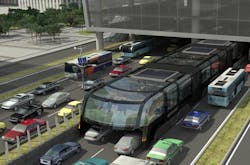As traffic volumes and population continue to grow in coming decades, it creates demand for more transportation infrastructure, but many countries don’t have sufficient money or space to build more roads and rails. The transportation systems around which the modern world has been built are on the verge of significant transformation. Transit Elevated Bus (TEB) technology emerges to help optimize roadway utilization, potentially saving billions in future infrastructure expansion. With the TEB technology, we will gain both environmental and economic development benefits.
TEB integrates the advantages of BRT (Bus Rapid Transit) and subway transportation technologies that can be used for highly trafficked roadways in cities. TEB can be an answer to serious congestion and pollution issues. Gridlock problems could become a history if the TEB technology is integrated with city transportation systems.
The TEB vehicle would run on embedded rails on both sides of the street. It is electrically powered traveling at average 30 miles per hour. The cost of construction is less than one-fifth that of a subway and the construction period can be completed in a year.
A TEB vehicle consists of two layers. The upper layer is for carrying passengers and the lower layer acts as a tunnel. Vehicles under two meters can go underneath, whether TEB is moving or stopped.
The Benefits
- Relief of Traffic Congestion – TEB can save road space by utilizing the vehicle upper layer for passengers. The design can reduce 25% to 35% of congestion caused by BRT (Bus Rapid Transit) directly or indirectly.
- High Efficiency & Large Passenger Capacity – each TEB can carry 1,200 passengers. Based on 40 vehicles and 40 km round-trip, it could carry about 400,000 passengers daily. The maximum speed is 60 km/h and the average speed is 40 km/h.
- Reduction of Air Pollution & Carbon Emission – TEB is powered by electricity. The average fuel consumption of each bus is 21.6t per year, and the estimated carbon emission of each bus is 66t. 40 city buses can be replaced by just one TEB for its lower emissions which will directly reduce 864t of fuel consumption and 2640t of carbon emission.
- Low Costs & Short Construction Period – TEB has several features and functions that are similar to subways. The average costs of construction of a subway are approximately $100 million USD per kilometer, but the average costs of construction of the TEB are estimated to be $20 million per kilometer.
“We are changing the way of transportation. Our mission is to provide environmentally friendly, energy efficient technologies and solutions to cities, countries and the world," said Mr. Zhiming Bai, president of TEB Technology
TEB in Action
TEB has been working with numbers of industry partners, professional research institutions and universities in various TEB research and development areas.
Based on the TEB design, the first model TEB vehicle is under construction by KTK Group, in Changzhou city, south China.
The TEB model vehicle will be ready for testing in August 2016 and have a planned TEB testing site in the city of Qinhuang Dao.
In December, 2015, TEB Technology has signed a strategic agreement with the city government of Zhoukou in Henan Province, China. In the agreement, the first R&D and industrial base will be established there with 500 acres of land allocated for TEB industrial park.
The city government of Zhoukou has planned to integrate the TEB transportation technology into the city’s transportation system. 200 km of TEB lanes are planned for the city to serve its 9 million people.
So far, TEB Technology has signed strategic cooperation agreements with city of Tianjin, city of Shenyang and city of Xiangfan.
At the 19th China Beijing International High-Tech Expo in April, 2016, a TEB scale model was showcased to the broad audience from China as well as from the world. Zhiming, told China’s Central Television network, CCTV News: “With a carrying capacity of 1200 people at a time, the TEB has the same functions as the subway while its cost of construction is less than one fifth of the subway.”



